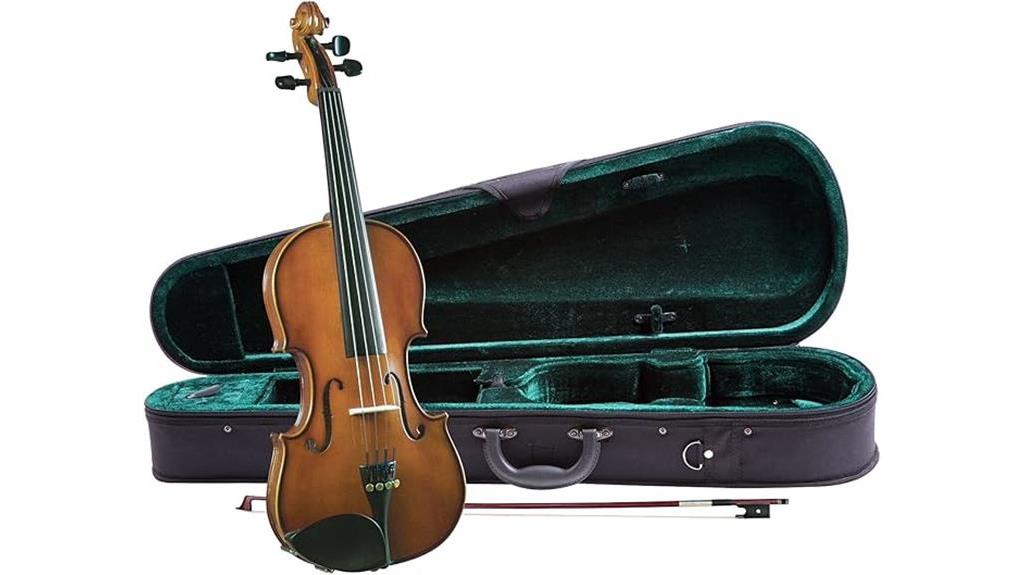Unveiling the Best Violins for Professionals: A Symphony of Craftsmanship, Tone, and Performance
When you’re searching for the best violins for professionals, it’s essential to evaluate factors like tonal quality, craftsmanship, and playability. You’ve likely heard of models like the One Piece Back Maestro Old Spruce Stradi and the Cremona SV-1240, but what truly sets them apart? Understanding the nuances of each instrument can make all the difference in your performance. Plus, exploring the legacies of renowned makers like Stradivari and Guarneri raises even more questions about value and sound. What might surprise you is how these choices can shape your musical journey in unexpected ways.
One Piece Back Maestro Old spruce Stradi 4/4 Violin
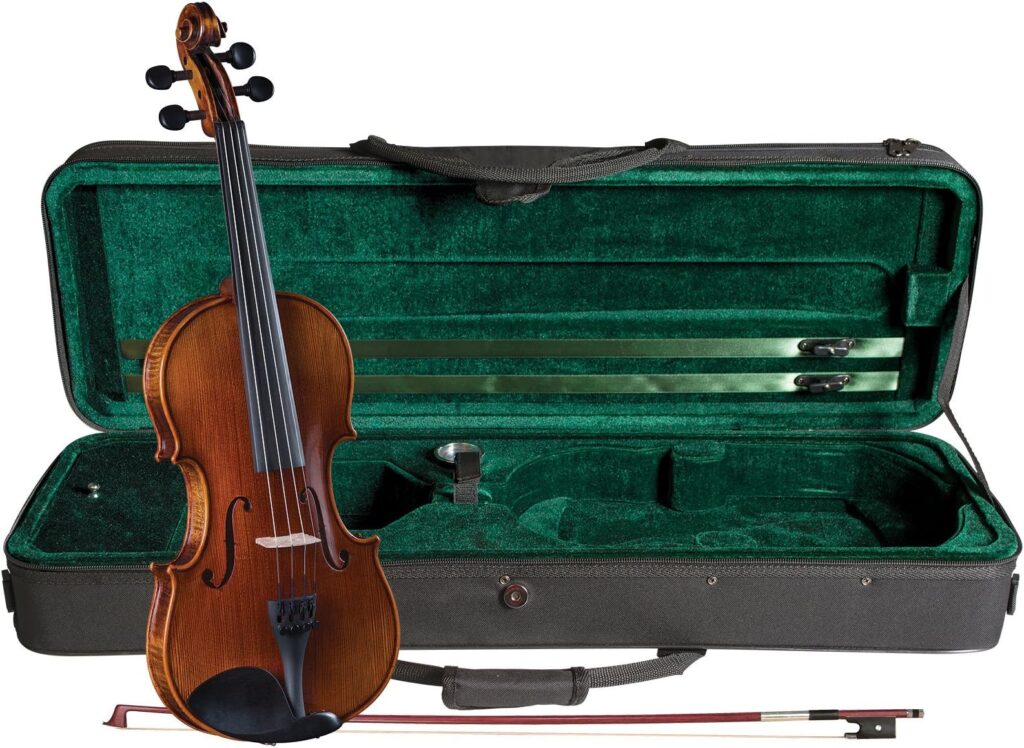
The One Piece Back Maestro Old spruce Stradi 4/4 Violin stands out for its powerful tone and meticulous craftsmanship, making it an exceptional choice for both aspiring and seasoned musicians. This violin is constructed from naturally seasoned tonewood, featuring an Alpine/Italian spruce top paired with select maple back and sides. This material selection considerably enhances its sound projection, allowing the instrument to produce a rich and resonant tone that fills any performance space.
One of the most compelling aspects of the Maestro Stradi is its tonal versatility. Whether you’re playing classical pieces in an orchestral setting or exploring more contemporary genres, this violin adapts beautifully. Its meticulously graduated design guarantees that the sound remains refined and sophisticated across a wide range of dynamics. You’ll appreciate how it delivers malleable tones, offering a depth of color that many smaller violins simply can’t match.
Customer feedback highlights the impressive sound quality and craftsmanship of the One Piece Back Maestro. Many players, from beginners to advanced musicians, report that this instrument serves as a reliable option for both personal use and as a spare for performances. Its ability to produce a powerful, nuanced sound makes it a standout choice for anyone looking to elevate their playing experience. Overall, this violin not only meets the demands of various skill levels but also enriches the musical journey with its remarkable sound projection and tonal flexibility.
Cremona SV-1240 Maestro First Violin Outfit – 4/4 Size
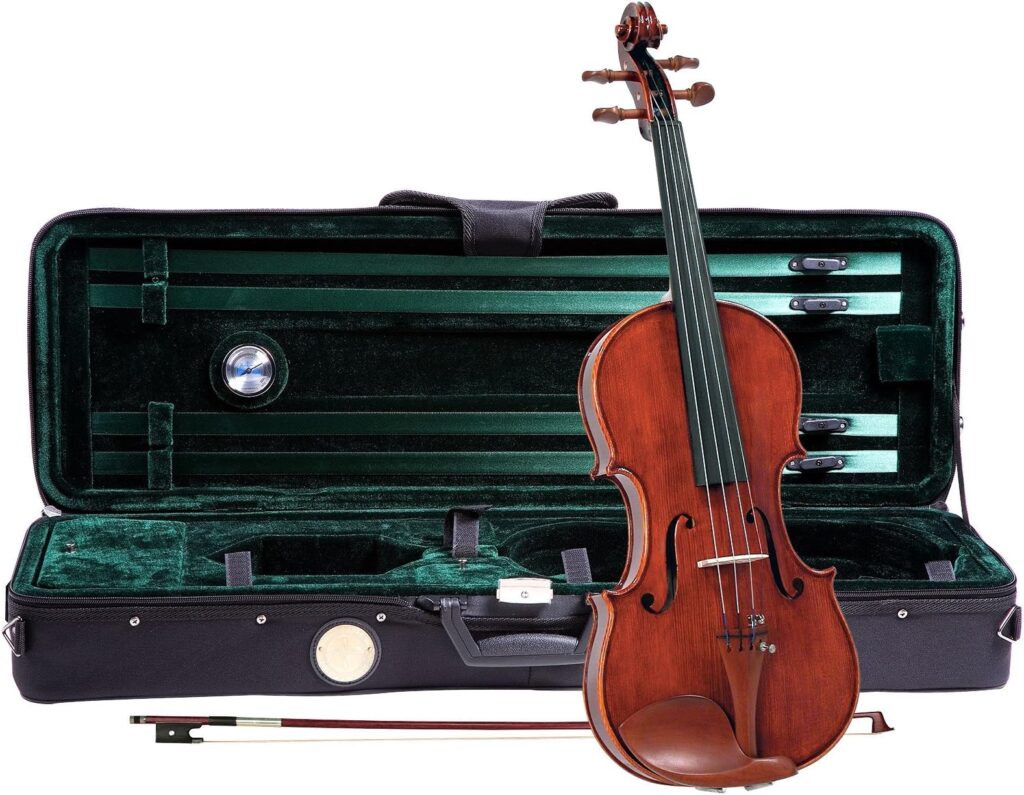
Cremona’s SV-1240 Maestro First Violin Outfit offers a compelling blend of quality construction and performance features tailored for serious musicians. This 4/4 size violin showcases exceptional Cremona craftsmanship, making it a top choice for players at various skill levels, including beginners. The hand-carved solid spruce top and flamed maple back and sides contribute to its rich tonal quality and aesthetic appeal.
Here are some key features of the Cremona SV-1240:
- Materials: Constructed with select solid wood, including an ebony fingerboard for enhanced playability.
- Bow: Comes with a well-balanced J. LaSalle LB-17 brazilwood bow, ensuring reliable performance.
- Strings: Equipped with Anton Breton VNS-150 Perlon strings for a clear, resonant sound.
- Case: Includes a lightweight Travelite TL-35 deluxe suspension case for protection during transport.
- Finetuner: Features a VP-14 finetuner for precise pitch adjustments.
With a customer rating of 4.6 out of 5 stars, users appreciate the SV-1240’s sound quality after string replacement and its overall workmanship. While it’s beneficial for beginners to gain experience, the violin’s superior construction also meets the expectations of more advanced players. This versatility makes the Cremona SV-1240 an excellent investment for anyone serious about their musical journey. Whether you’re just starting or looking to enhance your skills, this violin outfit provides a solid foundation for your future endeavors.
Cremona SV-500 Premier Artist Violin Outfit – 1/4 Size

Crafted for young musicians, the Cremona SV-500 Premier Artist Violin Outfit in 1/4 size delivers exceptional sound quality and playability tailored to the needs of advanced students and beginners alike. The instrument features a solid maple body, hand-carved spruce top, and flamed maple back, ensuring a rich tonal palette that enhances student performance. The hand-applied reddish-brown varnish not only adds aesthetic appeal but also contributes to sound improvement by allowing the wood to resonate freely.
Set up to MENC Standards, this violin includes a French-made Aubert bridge and US-made Prelude strings, which provide a reliable foundation for producing clear, vibrant tones. The quality Swiss-style ebony fittings and select ebony fingerboard further elevate the playability, allowing for smooth finger shifts and accurate intonation. Additionally, the lightweight composite tailpiece simplifies tuning, making it an excellent choice for young players mastering their craft.
User feedback consistently praises the Cremona SV-500 for its tone quality, often noted as one of the best for advanced students. While some users suggest upgrades to rosin and bow quality for enhanced sound performance, the overall satisfaction with the instrument’s price-to-quality ratio makes it a solid investment. The included deluxe Brazilwood bow and oblong case add to the value, ensuring that you have everything needed to excel in your musical journey.
Cremona SV-500 Premier Artist Violin Outfit – 4/4 Size
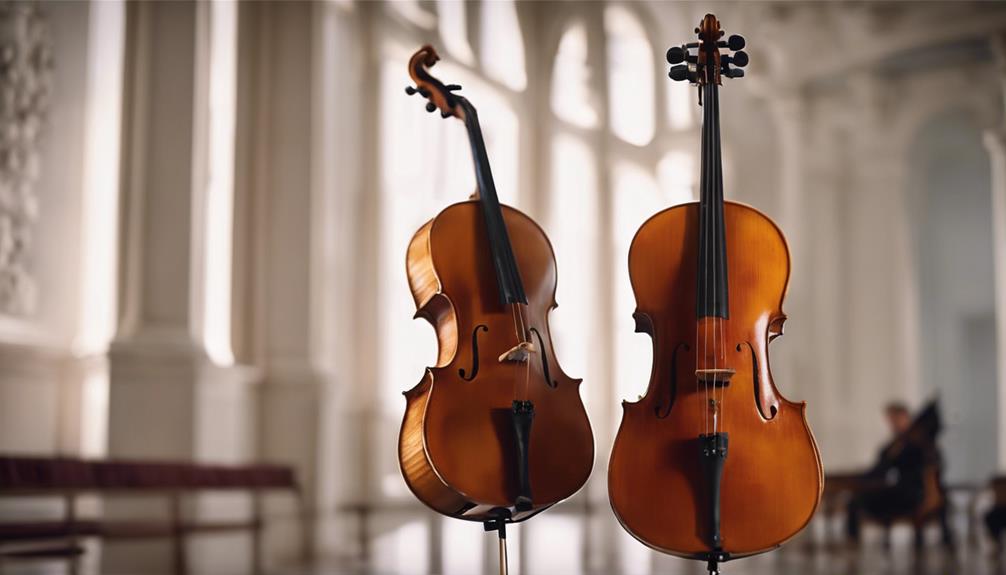
Designed for both beginners and advanced students, the Cremona SV-500 Premier Artist Violin Outfit in 4/4 size offers exceptional craftsmanship and sound quality that enhance your playing experience. This violin is constructed from high-quality materials, ensuring durability and performance.
- Flamed maple body with a hand-applied reddish-brown varnish
- Hand-carved solid spruce top for improved resonance
- French-made Aubert bridge for superior sound projection
- US-made Prelude strings for consistent tuning accuracy
- Lightweight oblong rigid foam case with storage for accessories
With its superior tone quality, the SV-500 has garnered positive student experiences across the board. Many users appreciate its ease of play, making it a reliable choice for both newcomers and returning players. The setup complies with MENC Standards, which means you can trust its build quality.
In terms of violin maintenance, the included manual provides essential guidance on tuning and care, contributing to the longevity of the instrument. Users often report being able to play within an hour of unboxing, showcasing its user-friendly design. While some have encountered packaging issues, the overall feedback highlights the SV-500 as a solid investment, particularly for those seeking a dependable second violin.
Ultimately, the Cremona SV-500 Premier Artist Violin Outfit stands out for its combination of quality, affordability, and excellent sound, making it an ideal choice for serious students in their musical journey.
Vangoa Electric Violin 4/4 Full Size Silent Violin Set for Beginner Adults Teens
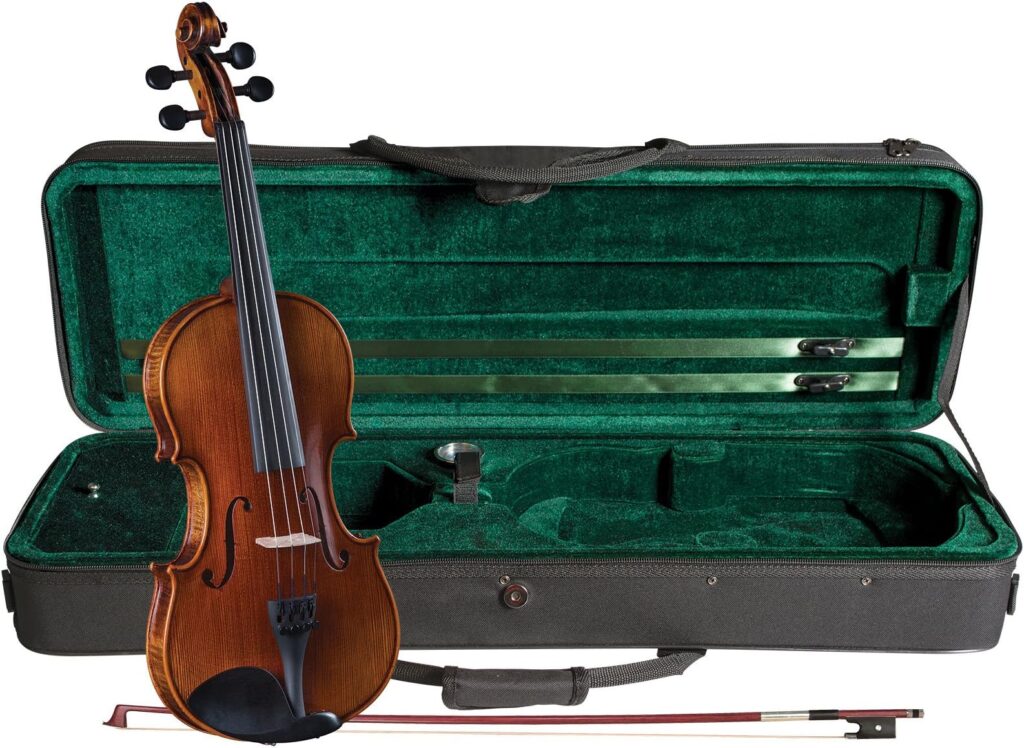
The Vangoa Electric Violin 4/4 Full Size Silent Violin Set offers a unique blend of user-friendly features and solid craftsmanship, making it an appealing choice for beginner adults and teens looking to explore the world of electric violins. Designed with a lightweight solid maple body and ebony fittings, this violin not only stands out visually with its Blue Vichy pattern but also guarantees comfort during extended play.
One of the key advantages of the Vangoa violin is its capability for silent practice. This feature allows you to practice without disturbing others, a significant benefit for those living in shared spaces. The violin is quieter than traditional acoustic models, making it ideal for beginners still working on their skills.
User-friendly controls, including volume and tone adjustments located on the back, help prevent accidental changes during a performance, enhancing your overall beginner experience. The included accessories, such as a shoulder pad, extra strings, and headphones, provide a thorough setup right out of the box, although some users may find benefits in upgrading certain components for improved sound quality.
Despite some reports of tuning stability and installation challenges with the bridge, the Vangoa Electric Violin remains a strong choice for casual players. With a decent sound quality and an average rating of 3.9 out of 5 stars, it caters well to those not pursuing professional performance while still delivering on the essential aspects of playability and practice.
Criteria for Professional Violins
When evaluating professional violins, you’ll need to focus on several key criteria. Tonal quality, playability, construction, and aesthetics play essential roles in determining a violin’s suitability for advanced performance. Understanding these factors will guide you in selecting an instrument that meets your professional needs.
Tonal Quality
Tonal quality in professional violins is primarily judged through characteristics like resonance, clarity, and richness, which greatly influence a player’s performance and expression. When evaluating a violin’s tonal quality, you should focus on how well it produces a rich resonance, allowing you to convey emotion and nuance in your playing. A violin with an excellent tonal quality will also exhibit a broad dynamic range, enabling you to perform both soft passages and powerful climaxes effectively.
Consider these key elements when evaluating tonal quality:
- Resonance: A violin should vibrate freely, producing a full, warm sound.
- Clarity: Each note must be distinct, allowing for articulate playing.
- Richness: The tone should have depth and complexity, engaging the listener.
- Projection: A good violin will project sound well, filling a concert hall effortlessly.
- Sustain: The ability of notes to linger adds to the overall expressiveness of your performance.
Playability
Playability in professional violins hinges on factors such as neck shape, fingerboard smoothness, and string action, all of which greatly impact a musician’s comfort and technique during performance. An ergonomic design is essential; the neck should fit comfortably in your hand, allowing for fluid movement across the fingerboard. A well-contoured neck reduces tension in your wrist and fingers, enhancing your overall playing experience.
The fingerboard’s smoothness directly affects your ability to execute fast passages and intricate finger patterns. A polished fingerboard guarantees minimal friction, promoting greater agility and accuracy. You’ll also want to take into account string action, which refers to the height of strings above the fingerboard. Ideal string action strikes a balance—too high can hinder your playing, while too low may cause buzzing.
Additionally, the spacing between the strings should accommodate your hand size and playing style, contributing to fingerboard comfort. Each of these elements plays a significant role in how easily you can navigate your instrument, allowing for greater expressiveness and technical proficiency. Ultimately, selecting a violin that excels in these playability aspects will empower you to reach your full potential as a professional musician.
Construction and Craftsmanship
The construction and craftsmanship of a professional violin are vital, as they directly influence both the instrument’s sound quality and its longevity, making attention to detail essential for discerning musicians. When evaluating a violin, you’ll want to focus on several key factors related to construction:
- Wood selection: High-quality tonewoods, like spruce for the top and maple for the back and sides, are important for producing a rich, resonant sound. The wood should be well-seasoned and free of defects.
- Arching: The curvature of the top and back affects the instrument’s tonal characteristics. A well-designed arch improves projection and tonal balance.
- Scroll and neck: The craftsmanship of the scroll and neck should reflect precision, ensuring proper alignment and stability, which impacts playability and sound.
- Varnish application: The finish influences the violin’s tonal properties. A thin, well-applied varnish allows for better sound transmission while protecting the wood.
- Setup: A professional setup, including proper string height and bridge adjustment, is essential for peak performance.
Aesthetics
A professional violin’s aesthetics not only enhance its visual appeal but also reflect the quality of craftsmanship and materials used, making it an essential consideration for discerning musicians. When evaluating a violin’s aesthetics, you should pay attention to the design influences that shape its overall appearance. Traditional designs often incorporate elegant curves and contours that not only serve a functional purpose but also add to the instrument’s beauty.
Color variations in the wood are vital as well. The choice of tonewoods, like spruce for the top and maple for the back, contributes to both the sound and the visual character of the instrument. Look for rich, warm hues and well-defined grain patterns that exemplify high-quality materials. Finishes, whether glossy or matte, can further enhance the violin’s aesthetics, providing a protective layer while influencing its visual depth.
Renowned Violin Makers
When considering the best violins for professionals, the contributions of renowned makers like Stradivari, Guarneri, and Amati cannot be overlooked. Each of these luthiers crafted instruments with unique sound qualities and construction techniques that continue to influence modern violin making. Additionally, contemporary master luthiers are pushing the boundaries of craftsmanship, creating violins that rival the historical greats in both performance and artistry.
Stradivari
Renowned for their unmatched craftsmanship, Stradivari violins have set the standard for professional instruments since the late 17th century. The Stradivari legacy is characterized by meticulous attention to detail, superior materials, and innovative design elements that continue to influence modern violin making. As a professional musician, you’ll appreciate how Stradivari craftsmanship enhances sound quality, projection, and playability, making these violins highly sought after.
Here are some key features of Stradivari violins:
- Exceptional Resonance: Their unique wood selection contributes to a rich, warm tone.
- Innovative Design: Stradivari experimented with shape and size, optimizing sound production.
- Historical Value: Owning a Stradivari isn’t just about quality; it’s an investment in history.
- Unique Characteristics: Each violin has distinct traits, shaped by the individual maker’s hands.
- Prestigious Reputation: Playing a Stradivari elevates your status among peers and audiences alike.
Guarneri
Guarneri violins, crafted by the legendary family of luthiers, are celebrated for their powerful sound and rich tonal qualities, making them a top choice among professional musicians. The Guarneri history dates back to the 17th and 18th centuries, particularly with the work of Giuseppe Guarneri del Gesù, whose instruments are highly sought after. His innovative approach to construction techniques, such as arching and wood selection, directly contributes to the distinctive Guarneri sound.
You’ll find that Guarneri violins typically produce a darker, more robust tone compared to their Stradivarian counterparts. This characteristic sound is often described as complex and vibrant, allowing musicians to convey a wide range of emotions. The use of thicker plates and a unique internal structure enhances projection and responsiveness, making them ideal for solo performances or orchestral settings.
With models like the “Cannone” and “Hart” leading the way, the Guarneri lineage continues to influence modern luthiers. Investing in a Guarneri violin means you’re not just acquiring an instrument; you’re embracing a rich tradition of craftsmanship that shapes your musical expression. In the world of professional performance, a Guarneri violin can elevate your artistry to new heights.
Amati
Amati violins, crafted by the influential Amati family in the 16th and 17th centuries, stand as proof of early violin-making innovation and are revered for their elegant sound and exquisite craftsmanship. The Amati history reflects a dedication to refining the violin’s design, which laid the groundwork for future makers. By utilizing carefully selected woods and experimenting with dimensions, they’ve created instruments that resonate beautifully and project sound with clarity.
Here are some notable aspects of Amati craftsmanship:
- Innovative Designs: Introduced features like the curved arching of the top and back.
- Material Selection: Used high-quality spruce and maple, enhancing tonal quality.
- Attention to Detail: Meticulous work on scrolls, purfling, and varnish finish.
- Sound Projection: Designed with a focus on volume and tonal richness.
- Legacy Influence: Inspired renowned makers like Stradivari and Guarneri.
Owning an Amati violin not only connects you to a rich heritage but also provides you with an instrument that embodies the pinnacle of early violin-making artistry. Their unique characteristics make them a coveted choice among professionals seeking both historical significance and superior sound quality.
Modern master luthiers
Modern master luthiers are pivotal in the evolution of violin-making, blending traditional techniques with innovative approaches to create instruments that meet the demands of today’s professional musicians. These artisans utilize advanced luthier techniques, meticulously honing their craft to produce violins that resonate with exceptional tonal qualities and playability.
You’ll notice that many luthiers are increasingly incorporating modern materials, such as carbon fiber and synthetic varnishes, alongside classic woods like spruce and maple. This fusion allows for enhanced durability and sound projection, addressing the practical needs of touring musicians.
Moreover, these luthiers often employ computer-aided design (CAD) tools to analyze acoustics and optimize the shape of their instruments, guaranteeing a perfect balance between aesthetic appeal and sound quality. By conducting extensive research on soundboard thickness and arching profiles, they can fine-tune the violin’s response across various playing styles.
Ultimately, when you invest in a violin crafted by a modern master luthier, you’re not just acquiring an instrument; you’re embracing a synthesis of time-honored craftsmanship and cutting-edge innovation. This combination guarantees that your violin meets the rigorous standards of professional performance.
Antique and Contemporary Violins
When considering antique and contemporary violins, you’ll find distinct advantages in both vintage instruments and modern handcrafted options. Antique violins often offer rich tonal qualities and historical significance, while contemporary models provide innovative designs and craftsmanship tailored to today’s performance demands. Evaluating your specific needs can guide you in selecting the right type of instrument for your professional pursuits.
Vintage instruments
Many professionals seek vintage violins for their unique tonal qualities and rich histories, which can greatly enhance performance and expression. The vintage craftsmanship found in these instruments often contributes to their exceptional sound and aesthetic appeal. When reflecting on a vintage violin, it’s important to recognize its historic value, as these instruments often carry stories that resonate with musicians and audiences alike.
Here are some key factors to think about when exploring vintage violins:
- Tonal Quality: Vintage violins typically offer a warmth and complexity that newer models may lack.
- Materials: Often constructed with aged woods, these instruments have developed unique tonal characteristics over time.
- Provenance: The history of the instrument, including previous ownership, can add to its significance and desirability.
- Condition: Evaluating the state of the instrument is essential, as repairs and restorations can impact both sound and value.
- Market Trends: Understanding current market values can help in making a wise investment.
Investing in a vintage violin isn’t just about acquiring an instrument; it’s about embracing a legacy that enhances your artistry.
Contemporary handcrafted violins
While vintage violins offer historical charm and unique tonal qualities, contemporary handcrafted violins present a remarkable opportunity for professionals seeking precision and innovation in their sound. These modern instruments are often crafted by skilled luthiers who utilize advanced techniques and materials, allowing for enhanced sound projection that can meet the demands of today’s performance environments.
Contemporary violins are designed with meticulous attention to detail, incorporating elements such as carbon fiber and innovative varnishing techniques. This not only elevates their durability but also enriches their tonal range, enabling you to achieve a broader spectrum of artistic expression. The combination of traditional craftsmanship and modern technology results in violins that can deliver exceptional clarity and resonance.
When you play a contemporary handcrafted violin, you’ll notice how it responds dynamically to your technique, allowing for nuanced interpretations of your repertoire. The precision in the setup, including the bridge height and string choice, contributes to a remarkable balance between warmth and brilliance in sound projection. For professionals, these instruments provide the flexibility needed to explore new artistic horizons without compromising on quality.
Conclusion
In your pursuit of the best violins for professionals, consider how each instrument’s craftsmanship and tonal quality can elevate your performance. Curiously, research shows that violins crafted by renowned makers like Stradivari and Guarneri can appreciate in value by up to 20% annually, making them not just musical tools but also sound investments. By understanding the nuances of each model and the significance of quality, you’ll be better equipped to choose an instrument that truly resonates with your artistry.

Lisa Maiers, a seasoned musician and dedicated music educator, brings her wealth of knowledge and passion for string instruments to the forefront in her latest guide, “Best Violins for Beginners.” With years of experience nurturing budding violinists, Lisa understands the critical role that the right instrument plays in a student’s musical journey. In this comprehensive guide, she offers invaluable insights and expert recommendations, helping beginners and their families make informed choices that foster growth, confidence, and a lifelong love of music. Whether you’re a parent seeking the perfect violin for your child or an adult embarking on a new musical adventure, Lisa’s expertise will guide you every step of the way.

